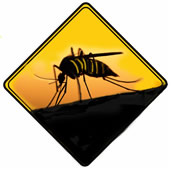COMMUNITY ALERT .....
Beware of new invasive Aedes aegypti mosquito makes first 2015 appearance in San Diego County

San Diego - County of San Diego environmental health officials have confirmed the discovery of another Aedes aegypti mosquito, a day-feeding invader that can carry serious diseases and was found here for the first time last year.
County of San Diego environmental health officials have confirmed the discovery of another Aedes aegypti mosquito, a day-feeding invader that can carry serious diseases and was found here for the first time last year.
County officials urged people to empty standing water inside and outside their homes to keep mosquitoes from breeding.
The newly discovered mosquito was found in an office in Chula Vista, near the areas where Aedes mosquitoes were first found in October, at Naval Base San Diego and a residence.
The Aedes aegypti mosquito, also known as the yellow fever mosquito, can carry serious diseases. However, those diseases — including yellow fever, dengue fever and chikungunya — are not native to San Diego County and are rarely seen here unless travelers contract them elsewhere and return home. There hasn’t been an outbreak of yellow fever in the U.S. in more than 100 years.
Despite that, environmental and public health officials are working to keep the mosquito from becoming established here because it can transmit those and other diseases. With the new discovery, the County has found a total of nine adult mosquitoes and two larvae sources since October.
The Aedes mosquito is fairly easy to identify. That’s because it differs from most native San Diego County mosquitoes in several important ways:
- It usually feeds during the day and is an aggressive biter. Most native mosquitoes prefer to feed between dusk and dawn.
- It likes to live in urban areas — feeding and laying eggs not only outside, but inside people’s homes in almost anything that can contain water, including plant saucers, cups and flowerpots.
- It is small and black with white stripes. |